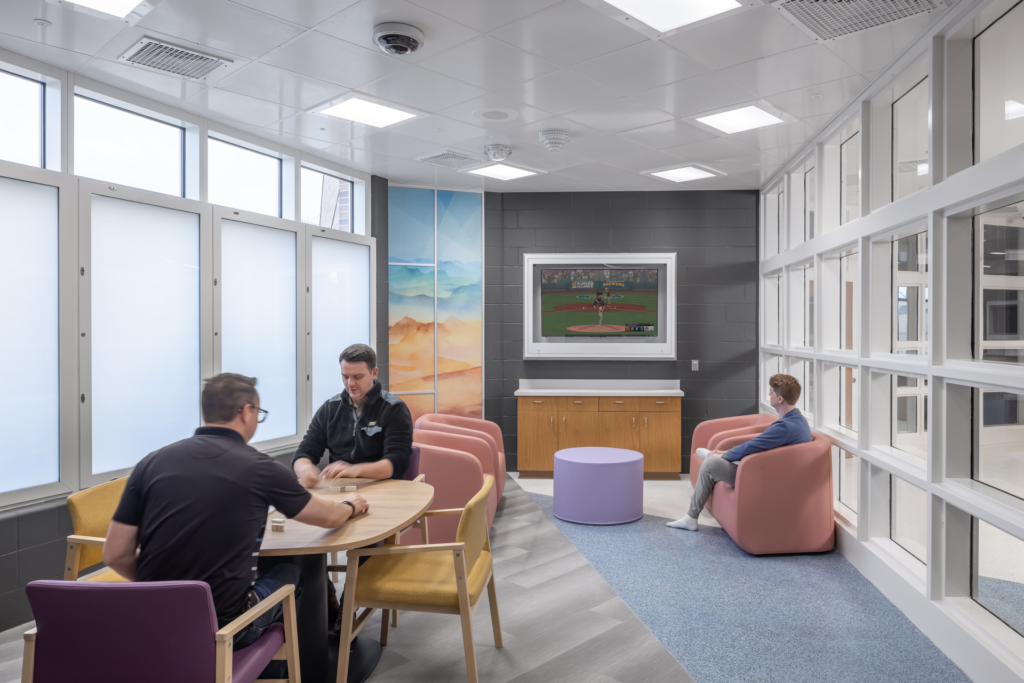Architecture and interior design hold incredible power to impact lives—improving patient outcomes, increasing staff retention, and creating safer environments that reduce risk and errors are just a few examples of the far-reaching effects that design can bring to facilities. Though it may seem like a creative pursuit, the work of designing informed environments that drive these powerful results is rooted in research.
Evidence-Based Design (EBD) bases design choices on credible research in order to achieve the best possible outcomes. Designers with EDAC certification demonstrate the ability to apply this process to facility design, including measuring and reporting results. While traditionally seen in healthcare environments where it has been proven to improve HCAHPS scores reflecting patient experience, an evidence-based approach can also provide meaningful impact in forensic facilities. We’ve begun to see an evolution of forensic facilities moving toward behavioral treatment approaches, bringing a greater focus on therapeutic, dignified healing, and it’s crucial that architecture and interior design support this.
Clearly in Evidence
Principles like nature-inspired design, access to daylight, and providing users with a sense of control in their environments come from evidence-based design, with studies backing their effectiveness in reducing stress or aggression, increasing user satisfaction, and overall creating better places to heal. BWBR’s signature approach to EBD is Human-Centered Safety®, which follows similar guiding principles backed by research and is particularly focused on improving treatment outcomes, safety, and patient satisfaction in behavioral health centers.
The BWBR team has witnessed first-hand the impacts of these proven strategies in our projects, like the Minnesota Security Hospital (MSH), a facility for forensic patients designated as mentally ill and dangerous. After years of working around blind spots, corners, split-levels, and overall outdated facilities, MSH knew that the existing layout was not conducive to effective care or patient and staff safety. The new design centered around creating a quiet, calm environment with smaller housing units, integrating soothing color themes and soft lighting, and maximizing visibility to improve safety. Within the first three years of the expansion and renovation opening, the facility saw transformative results: staff injuries decrease by 51%, Workers’ Compensation claims go down by 35%, and cases of aggressive behavior in patients reduce by 52%.
Rehabilitation Beyond Sanctions
The Mendota Juvenile Treatment Center (MJTC) is one of BWBR’s latest projects utilizing EBD practices to create a secure facility that supports a trauma-informed, treatment-based program. The MJTC offers comprehensive services to youth and teens who need intensive behavioral and mental health treatment beyond a traditional sanctions-based approach. Their existing building was not optimized to support the program’s model of care, treatment, and education, so the renovation and expansion provided an opportunity to purpose-build and expand services to include girls.
Together with EBD, hope and joy were key concepts in the design process—abundant windows, positive distractions, wall graphics depicting themes of nature, and pops of color starkly contrast the cold, institutional imagery commonly associated with forensic facilities. The result is an environment that reflects the positive, therapeutic support that MJTC staff provide to very high-risk youth, promoting prosocial behavior and healing.
At another in-progress youth project, the Juvenile Correctional Facility in Milwaukee, designers met with adolescents housed in the center to select wall graphics for the space. Rather than nature-inspired art, as the design team expected, the residents instead gravitated toward themes of people and community—representative of the relationships built with staff and peers throughout the programming. Along with colorful wall paint and plenty of windows providing views of nature, these EBD strategies create environments that feel hopeful and inspiring, reduce stress and agitation, and help contribute to the holistic treatment that takes place inside.
The Future of EBD is Bright
As designers continue to put new theories to the test, completing post-occupancy studies and seeing results in action, we’re able to build a stronger understanding of design’s impact on wellbeing—and not only in the realm of healthcare. Forensic projects, behavioral and mental health facilities, workplaces, educational environments, and beyond can all benefit from elements of EBD, opening the door to more thoughtful, human-centered spaces across diverse sectors.
Behavioral health research and design is vastly expanding, too. Community-engaged design models, enabling facilities to act as community centers where conferences, meetings, and classes are hosted, are emerging to help eliminate stigma around behavioral and mental health environments. Studies surrounding Environmental Enrichment continue to explore the relationship between design and behavioral improvements, with research indicating that dynamic environments with motor, sensory, cognitive and social stimulation may support positive changes in neurological function. These strategies are still evolving, but with behavioral and mental health coming to the forefront in how designers and stakeholders approach facility design, it’s clear that EBD holds great potential to transform healing and rehabilitation.








